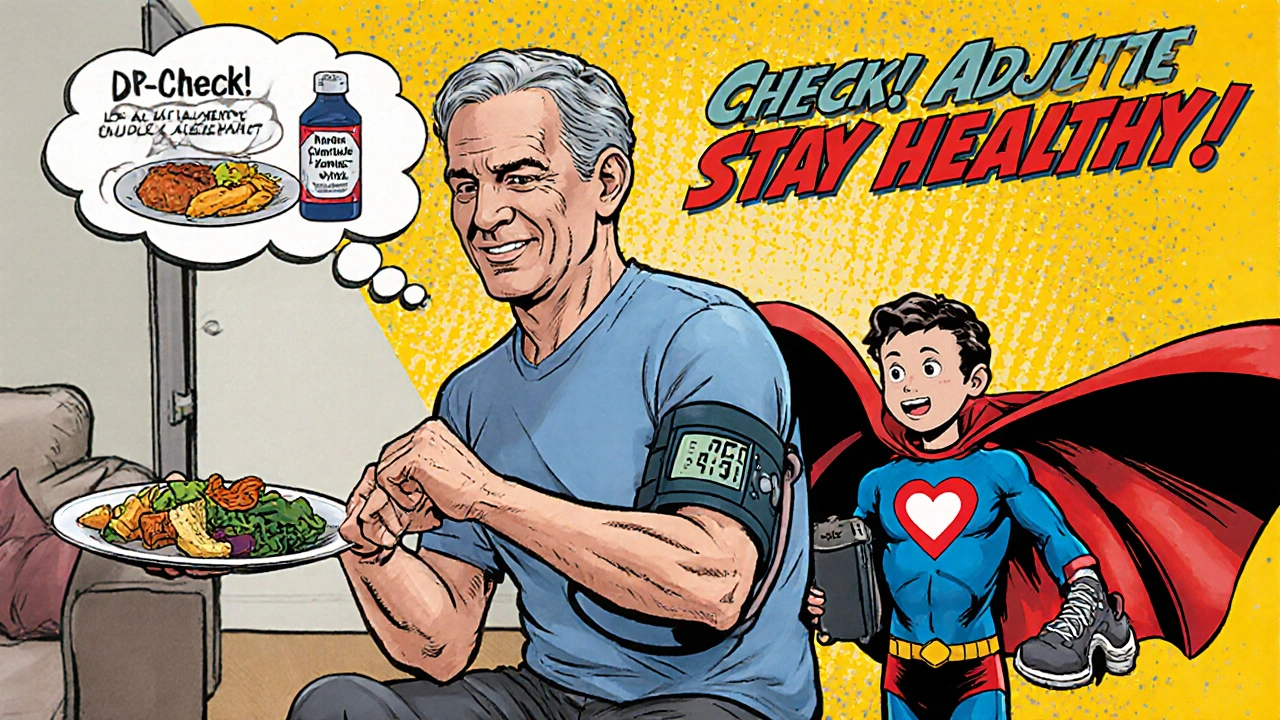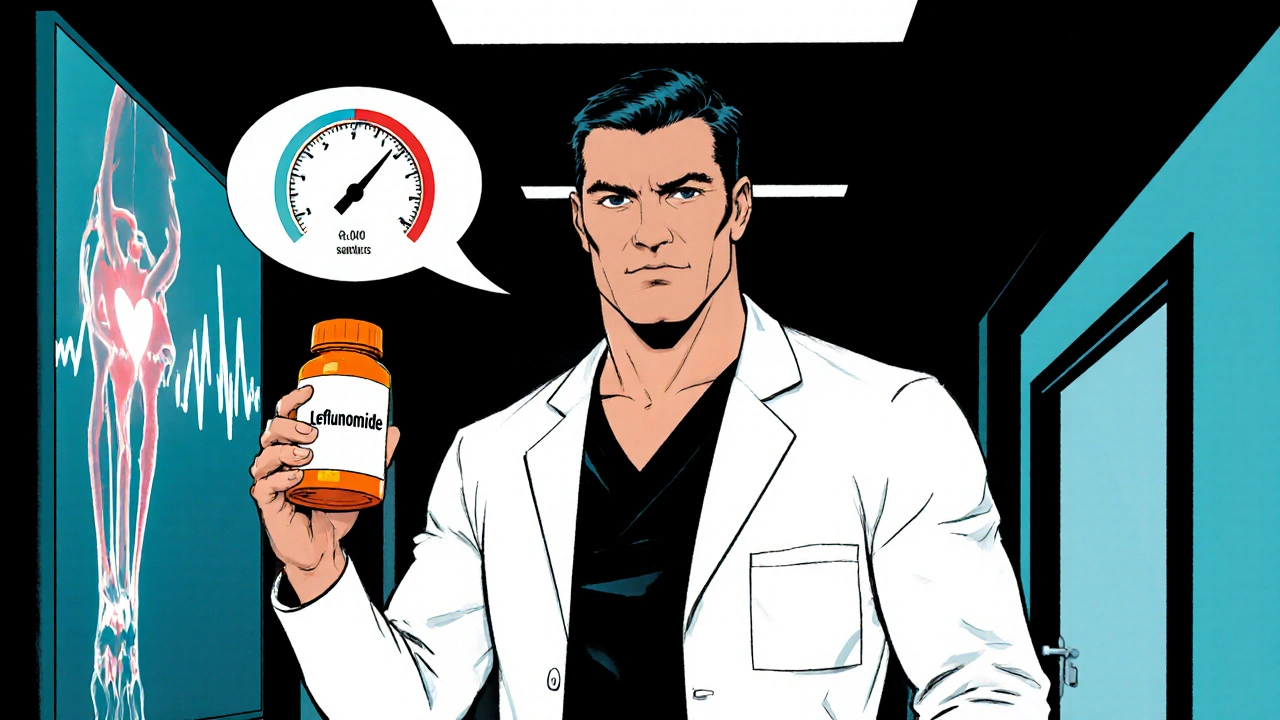Leflunomide Blood Pressure Risk Calculator
Risk Assessment
This tool estimates your risk of experiencing blood pressure elevation while taking leflunomide based on your individual characteristics. Results are for informational purposes only and should not replace professional medical advice.
When you’re prescribed Leflunomide is a disease‑modifying antirheumatic drug (DMARD) that works by inhibiting dihydroorotate dehydrogenase, reducing the production of activated immune cells. It’s a go‑to for many people with rheumatoid arthritis, but you might have heard that it can mess with your blood pressure. This article breaks down the science, the real‑world data, and what you should do to keep your heart happy while staying on the drug.
Key Takeaways
- Leflunomide can modestly raise systolic blood pressure in a subset of patients, especially those with pre‑existing cardiovascular risk.
- The rise is usually linked to fluid retention and subtle changes in kidney function rather than a direct pharmacologic effect.
- Regular monitoring-baseline, 4‑week, and quarterly thereafter-helps catch any rise early.
- Lifestyle tweaks, antihypertensive adjustments, or switching to another DMARD are effective ways to manage the issue.
- Most patients stay on leflunomide without trouble if the rise is mild and managed promptly.
Understanding Leflunomide
Beyond the definition above, leflunomide is taken orally once daily, usually at a loading dose of 100mg for three days followed by a maintenance dose of 20mg. Its active metabolite, teriflunomide, remains in the body for weeks, giving the drug a long‑lasting effect.
Key attributes:
- Class: Immunosuppressant DMARD
- Primary use: Rheumatoid arthritis, psoriatic arthritis
- Mechanism: Inhibits dihydroorotate dehydrogenase, cutting down pyrimidine synthesis in rapidly dividing lymphocytes
- Half‑life: ≈2 weeks for teriflunomide
Blood Pressure Basics
Blood pressure (BP) is the force of blood against artery walls, expressed as systolic/diastolic (e.g., 120/80mmHg). Hypertension is a chronic elevation of this pressure, usually defined as ≥130/80mmHg in modern guidelines. Persistent high BP strains the heart, kidneys, and blood vessels, raising the risk of heart attack, stroke, and kidney disease.

What the Research Says About Leflunomide and BP
Several post‑marketing studies and registry analyses have looked at leflunomide’s cardiovascular profile. The most cited data come from three sources:
- A 2021 meta‑analysis of 12 randomized controlled trials (RCTs) involving 4,200 rheumatoid arthritis patients. The pooled mean increase in systolic BP was 3mmHg (95%CI1-5), statistically significant but clinically modest.
- A real‑world cohort from the UK Biobank (2023) tracking 1,150 leflunomide users for up to five years. About 12% developed new‑onset hypertension, compared with 8% of methotrexate users.
- Pharmacovigilance reports submitted to the European Medicines Agency (EMA) in 2024, noting 214 cases of “significant BP rise” linked to leflunomide, most of which resolved after dose reduction or drug discontinuation.
Takeaway: the drug can nudge BP upward, but the effect is usually small and depends on individual risk factors.
Who Is Most Likely to See a BP Rise?
Not everyone gets the same reaction. The following groups have a higher odds ratio (≈1.6‑2.0) for BP elevation while on leflunomide:
- Patients over 60years of age
- Those with baseline pre‑hypertension (120‑129/80‑84mmHg)
- Individuals with chronic kidney disease (eGFR<60mL/min/1.73m²)
- People on concomitant non‑steroidal anti‑inflammatory drugs (NSAIDs) or high‑salt diets
- Smokers and patients with a family history of hypertension
The mechanism appears to be two‑fold: leflunomide can cause mild fluid retention, and it may mildly reduce renal perfusion, prompting the kidneys to retain sodium.
Monitoring Blood Pressure While on Leflunomide
Because the risk is real but manageable, guidelines from the American College of Rheumatology (ACR, 2022) recommend a simple monitoring schedule:
- Baseline: Record both office BP and, if possible, home BP over three consecutive mornings.
- Week4: Repeat office measurement; adjust antihypertensives if systolic ≥140mmHg or diastolic ≥90mmHg.
- Every 3‑6months: Ongoing checks, especially after dose changes or if other medications (e.g., NSAIDs) are added.
Patients should be taught to use validated home BP cuffs and keep a log. Any jump of more than 10mmHg from baseline deserves a clinician’s review.

Managing an Elevated BP Reading
If your BP climbs, you have several options before dropping leflunomide altogether.
- Lifestyle tweaks: Reduce sodium intake to <2g/day, add a brisk 30‑minute walk most days, limit alcohol to ≤1drink for women and ≤2 for men.
- Medication adjustment: Introduce or uptitrate an ACE inhibitor or a thiazide‑type diuretic. These agents counteract fluid retention and improve renal handling of sodium.
- Dose reduction: If you’re on 20mg, a temporary drop to 10mg for a month can lower BP without sacrificing disease control.
- Switching DMARDs: For persistent hypertension despite the above, consider moving to methotrexate, sulfasalazine, or a biologic agent.
Any change should be coordinated with your rheumatologist to ensure arthritis remains under control.
How Leflunomide Stacks Up Against Other DMARDs
| DMARD | Mean SBP Change (mmHg) | Typical Side‑Effect Profile | Renal Considerations |
|---|---|---|---|
| Leflunomide | +3 (±2) | Hepatotoxicity, alopecia | Mild reduction in eGFR |
| Methotrexate | +1 (±1) | Gastro‑intestinal upset, lung toxicity | Generally renal‑neutral |
| Sulfasalazine | +0.5 (±0.5) | Rash, oligospermia | Renal‑neutral |
| Biologic (TNF‑α inhibitor) | 0 (±1) | Infection risk, injection site reactions | Renal‑neutral |
While leflunomide tops the list for BP rise, the difference is modest. The choice of drug should balance arthritis control, overall safety, and personal cardiovascular risk.
Frequently Asked Questions
Can leflunomide cause hypertension?
Yes, studies show a small average increase in systolic blood pressure, typically around 3mmHg. The risk is higher if you already have borderline BP or kidney issues.
Do I need to stop leflunomide if my BP goes up?
Not immediately. Doctors usually try lifestyle changes, adjust antihypertensive meds, or lower the leflunomide dose first. Switching is considered only if BP stays high despite those steps.
How often should I check my blood pressure while on leflunomide?
Start with a baseline, then a check at four weeks, and subsequently every three to six months. Home monitoring is encouraged for any sudden rise.
Are there specific antihypertensive drugs that work best with leflunomide?
ACE inhibitors or ARBs are popular because they protect kidney function and counteract fluid retention. Thiazide diuretics are also effective, especially if salt intake is high.
What other side‑effects should I watch for?
Common issues include liver enzyme elevations, hair thinning, and gastrointestinal upset. Rare but serious concerns are severe infections and lung toxicity. Regular lab tests help catch these early.
Bottom Line
For most patients, leflunomide remains a powerful tool against rheumatoid arthritis. The connection to blood pressure is real but modest, and it can be handled with routine monitoring, simple lifestyle tweaks, and, when needed, a tweak to your antihypertensive regimen. If you notice a persistent rise, talk to your rheumatologist-often a small adjustment prevents a big problem.

Dan Barreto da Silva
August 21, 2025
Listen up, leflunomide can be a sneaky beast for your blood pressure if you’re not watching the numbers. It’s not a silent killer, but it does push systolic up a notch in people with pre‑existing risks. Keep that baseline reading and come back for a check‑up every month when you start the drug. If you notice a steady climb, it’s time to talk to your doc about tweaking the dose or adding a little antihypertensive help.
Ariel Munoz
August 30, 2025
American folks need to stay sharp on this – leflunomide isn’t just another pill you pop without consequences. The data shows a modest rise in systolic pressure, especially in older patients. Make sure your doctor runs a full cardio panel before you even think about the loading dose. It’s about protecting your heart while you fight the arthritis.
Ryan Hlavaty
September 8, 2025
First and foremost, patients must recognize that leflunomide carries a non‑trivial risk of elevating blood pressure, and willful ignorance is unacceptable. The mechanism involves subtle fluid retention and a mild nephrotoxic effect that can compound existing hypertensive tendencies. Ignoring baseline readings is tantamount to negligence on the part of the patient and the prescribing clinician. Regular monitoring is not a suggestion; it is an ethical imperative that should be built into any treatment plan. If you are over sixty, the risk score triples, and that fact must be communicated transparently. Those with pre‑hypertension should view the drug as a potential catalyst rather than a benign therapy. Kidney function tests should be performed before initiating therapy and repeated after the loading phase. A patient who experiences a rise of three to five millimetres of mercury should consider dose reduction without delay. The literature consistently shows that the average systolic increase hovers around three mmHg, but outliers can rise much higher, sometimes crossing the threshold for stage one hypertension. Lifestyle modifications-low‑salt diet, regular aerobic exercise, and limiting alcohol-remain the first line of defense. Should the BP continue to climb despite these measures, the addition of an ACE inhibitor or ARB is justified. In some cases, the safest course is to switch to an alternative DMARD with a more favorable cardiovascular profile. Physicians have a duty to discuss these possibilities upfront, allowing patients to make an informed choice. Ultimately, the goal is to balance disease control with cardiovascular safety, and that balance requires vigilance, not complacency. Every stakeholder-from the rheumatologist to the primary care provider-must stay engaged in the monitoring process.
Chris Faber
September 17, 2025
Just a heads‑up, the BP bumps from leflunomide are usually mild and manageable. I’ve seen most mates keep it under control with quarterly checks. If you spot a drift, a quick chat with your doc usually sorts it out.
aura green
September 25, 2025
Honestly, it’s kinda funny how many people panic over a three‑point rise when the real battle is keeping the arthritis in check. 😏 Regular monitoring isn’t some bureaucratic hoop, it’s your safety net. If you’re already tweaking your diet and staying active, those extra millimetres won’t ruin your day. And hey, a little antihypertensive isn’t the end of the world – it’s a bridge to feeling better overall. So chill, stay consistent, and let your doc handle the tweaks. 💪
Edward Morrow
October 4, 2025
Let’s cut the nonsense – leflunomide can shove your BP up, and if you’re not tracking it, you’re courting disaster. The drug’s side‑effects aren’t a myth, they’re in the FDA reports. Get yourself a home cuff and don’t be a slacker.
Shayne Tremblay
October 13, 2025
Motivation time! You’ve got this – just keep an eye on those numbers and don’t let fear stop you from beating RA. A simple weekly log can be a game‑changer. Remember, staying proactive is the best defense.
Stephen Richter
October 22, 2025
Just another pill, folks.